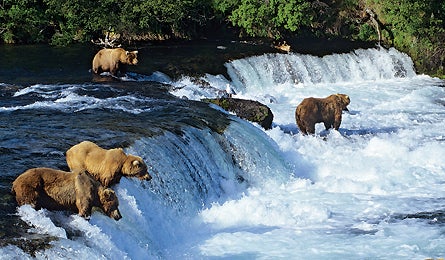Where to See Bears

'Bears fishing in Alaska (Tom & Pat Leeson)'
Range
Grizzlies inhabit western Canada and the northwestern U.S., and black bears live everywhere from Alaska to Mexico.
Where
Berry patches and fish-rich streams Ask local land managers what bears are currently feasting on. If it’s berries, find out where the thickest fruiting patches are. If it’s salmon, identify rivers with the densest runs (population data available from land managers or on fish-and-game websites) and scope out the banks.
Near carcasses In spring, ask managers where winter snows claimed the most ungulates, and hike those zones—cautiously.
Talus fields In summer in Yellowstone, Glacier, and across the Rockies, bears roam the talus, gorging on army cutworm moths.
Ground-squirrel fields Black bears don’t dig for squirrels, but grizzlies do. “It’s a great show to watch a grizzly dig out and chase a ground squirrel,” says wildlife biologist and bear expert Steve Herrero. “Bears are surprisingly fast.” Find ground-squirrel metropolises in meadows throughout the northern Rockies and Alaska.
When
Spring Hungry from hibernation, bears are busy foraging and are more likely to spend daylight hours in the open than when summer’s heat drives them to feed at night. When the snowpack starts to melt, look for bears on south-facing slopes just free of snow; they munch the tender plants sprouting there. By midsummer, most bruins will have moved to higher elevations.
Fall Bears enter a period of around-the-clock foraging come September, which gets them out in the open again during the day. In places like Denali, hyperphagic grizzlies’ brown coats stand out against the cranberry-red soapberry slopes; Backpacker
staffers have seen six on a single 10-hour hike in one drainage.
Dawn and dusk in the summer Bears seek cooling shade midday.
How
Excited cries from ravens and crows might mean bears have hijacked their food. And coyotes or gray jays with meat in their mouths can tip you to a nearby carcass. Listen also to birds and squirrels, which “are alarm animals,” says Alaska-based wildlife photographer John Hyde. “When they get upset, I know something’s going on nearby.”
Observe game trails—very carefully. Bear traffic around good salmon spots creates paths and tunnels through streamside shrubbery. But don’t follow these trails blindly, quietly, or alone—and have your bear spray at the ready: Surprising a bear in such close quarters is a great way to provoke an attack. Sing out as you hike, and stop often to look and listen.
Scan the ground for tracks and scat; the latter often looks like a plump, round pile with partially digested berries and foliage, but can sometimes be more segmented. Also look for “rub trees” where bears have deposited their hair and scent to mark territory; the tree trunk usually exhibits claw marks, clumps of hair, and missing bark.
Top spots
For grizzlies galore, hike the Garden Wall via the Highline Trail (11.3 miles round-trip), in Glacier NP. To see black bears, hit Virginia’s acorn-rich Whiteoak Canyon Trail in Shenandoah NP.